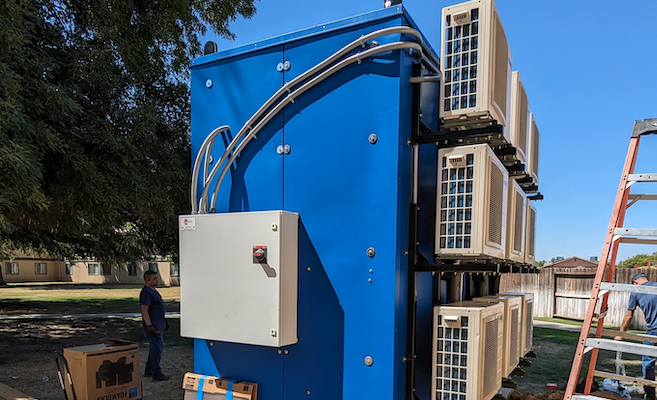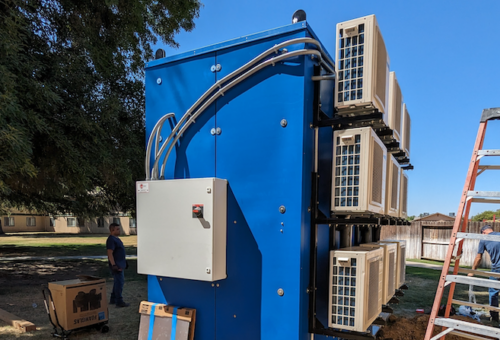Project Overview
At a disability and elder care facility in central Calif., constant recirculation and poorly insulated piping contributed to high energy use of two central water heating plants using commercial gas tank-type water heaters. Additional energy losses came from the unintended flow of hot water into the cold water system, and vice versa (i.e., crossover).
After considering multiple heat pump water heater (HPWH) systems with low global warming potential (GWP) refrigerants, the project team decided on the packaged WaterDrop system to capitalize on the potential of a fully skid-built system, especially as the site includes large, landscaped areas that provide ample space for the outdoor installation. The original design included six heat pumps, but three additional heat pumps were added to accommodate future increases in occupancy. To further improve the efficiency of the system, thermostatic balancing valves and variable speed recirculation pumps were used to balance the recirculation system and reduce energy loss. Finally, the team replaced shower cartridges in one wing to address the crossover issues.
The installation was completed in three days, as compared to site-built system installations, which can take weeks. The water heating manufacturer, Small Planet Supply, worked onsite to complete commissioning. The project team will collect data for nine months to monitor system operations, including efficiency, energy consumption, and load-shifting performance.

Image source: Carbon Zero Buildings
Solution
Two Small Planet Supply WaterDrop packaged skid systems serve the building, which was previously served by two separate gas water heating plants. Each skid consists of 9 low-GWP heat pumps that use CO2 as the refrigerant, a 505-gallon storage tank, and a 120-gallon swing tank. The skid is installed outdoors, near the existing electrical room.
Project funding
The project was funded at no cost to the building owner thanks to an EPIC grant from the California Energy Commission, along with funding from the Low-Income Weatherization Program and the TECH Clean California program.
Operational cost
As installed, the system is expected to be nearly cost-neutral, relative to the gas plant, due to high electricity costs in the region. And with the installation of the planned Virtual Net Metering (VNEM) solar photovoltaic system, the owner’s costs are expected to be near zero.

